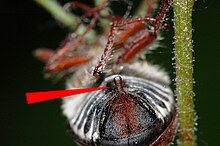Pygidium (insects)
In some groups of insects the pygidium describes the hardened (sclerotized) back shield ( tergite or tergum) of the last freely visible abdominal segment . The various structures known as pygidium have arisen convergently in the various insect orders and are not homologous , for example they lie on different segments . There are also non-homologous structures known as pygidium in other animal groups . In many beetles and hymenoptera the pygidium is where the pygidial glands are located .
Beetle

In the beetles (Coleoptera) the pygidium is the tergite of the abdominal segments seven or eight, depending on the family . The pygidium can be covered by the elytra or elytra in the rest position, or these are shortened at the end so that it is exposed. For some authors, only an exposed one is a real pygidium. The remaining abdominal tergites, covered by the elytra, are often deslerotized, white in color and soft-skinned. If the wing covers leave two tergites uncovered, the one in front is often referred to as propygidium. The beetle's pygidium is also called the “anal shield” or “anal cover”.
The pygidial glands opening onto the pygidium are defensive glands in numerous groups of beetles, but in some cases they also have other functions. For example, they can release a secretion from beetles that live on the surface of the water, such as tumble beetles or some rump-winged beetles , which reduces the surface tension of the water and thus catapults the animal forward. For reasons of homology, they are called this in the rump-winged beetles.

Hymenoptera
In the hymenoptera, the pygidium is the tergite of the seventh abdominal segment. As with the beetles, some hymenoptera have pygidial glands, which serve as defensive glands in ants , for example . In bees and other aculeata , a so-called pygidial field is often formed on the pygidium. This is an approximately triangular structure, laterally limited by keels, which, for example, can be of importance in nest building for burrowing species.
Catchy tunes
In the earwigs , the pygidium sits, depending on the species, on the abdominal segments eight, nine, ten or eleven, or from two fused segments; in the common earwig , for example, it is the eleventh. In many species the pygidium protrudes backwards between the pincers (anatomically: cerci).
Individual evidence
- ^ Rolf G. Beutel, Richard AB Leschen: Handbuch der Zoologie - Coleoptera, Beetles, Volume 1: Morphology and Systematics (Archostemata, Adephaga, Myxophaga, Polyphaga partim). 1st edition. de Gruyter, 2005, ISBN 3-11-017130-9
- ^ RA Crowson: The Biology of the Coleoptera. Academic Press, 2013, ISBN 978-1-4832-1760-4
- ^ A b Gordon Gordh & David Headrick: A Dictionary of Entomology. CABI Publishing 2001, ISBN 978-0-85199-291-4
- ↑ Heinz Freude , Karl Wilhelm Harde , Gustav Adolf Lohse (ed.): Die Käfer Mitteleuropas (= Käfer Mitteleuropas . Volume 1 : Introduction to Beetle Science ). 1st edition. Goecke & Evers, Krefeld 1965, ISBN 3-8274-0675-7 .
- ↑ Kevina Vulinec (1987): Swimming in Whirligig Beetles (Coleoptera: Gyrinidae): A Possible Role of the Pygidial Gland Secretion. Coleopterists Bulletin Vol. 41, No. 2: 151-153.
- ↑ Katsuo Kaneshisa & Hisaaki Tsumuki (1996): Pygidial secretion of Stenus rove beetles (Coleoptera, Staphylinidae). Bulletin of the Research Institute for Bioresources Okayama University 4: 25-31.
- ^ Bert Hölldobler & Hiltrud Engel (1978): Tergal and sternal glands in ants. Psyche vol. 85, no. 4: 285-330.
- ↑ Klaus Günther & Konrad Herter: Dermaptera (earwigs). Handbuch der Zoologie Vol. 11. Verlag Walter de Gruyter, 1974, ISBN 978-3-11-004933-6